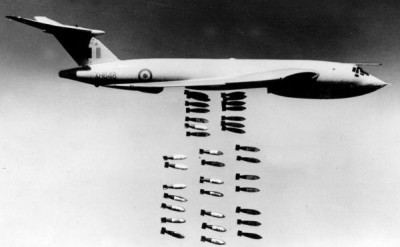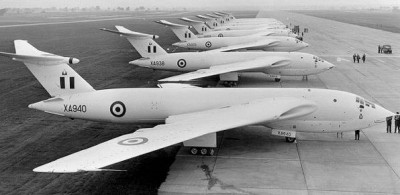|

Handley Page Victor

The Victor was the third of Britain's V
bombers to fly and despite being less well known than the Vulcan it was
arguably the best of the three. The Victor was faster, higher flying and
capable of carrying a heavier bombload than both the Valiant and Vulcan.
The aircraft featured a unique crescent shaped leading edge on the swept
wings and tail horizontal surfaces. The 50 initial Victor B.1's entered
service in 1958 and these were powered by four Sapphire turbojets. From
1960 24 were fitted with additional ECM gear to become B.1A's. The Victor
B.2 entered service from 1962 and featured more powerful Rolls-Royce
Conway 200 turbofans. Thirty four were built and most were later upgraded
to B.2R standard with even more powerful Conway 201's. Nine B.2's were
converted to B(SR).2 standard with cameras and SLAR for the strategic
reconnaissance mission. By 1968 the B.2R had been withdrawn from service
and the B(SR).2's had followed by 1975. However Victors retired from their
frontline role moved on to become tankers. Thirty-one B.1/B.1A's were
converted to K.1/K.1A tankers from 1965 and from 1972 they were joined by
24 converted B.2s and SR's as K.2's. The K.2's saw extensive service in
the Falklands and the 1991 Gulf War before being finally retired in 1993.

General
Crew Five (Pilot, Co-pilot, Air Electronics Officer, Nav-Radar
Operator and Nav-Plotter)
Powerplant
Number Of Engines Four
Powerplant type Rolls Royce Conway RCo17 Mk 201 non-afterburning turbofan
Max Power Rating 9,344kg
Dimensions
Length 35.03m (114ft 11in)
Height 8.57m (28ft 1.5in)
Wingspan 34.44m (113ft)
Wing Area 204.38m2 (2,200sq ft)
Weights
Empty Weight 51,936kg (114,500lb)
Max Take-off Weight 107,955kg (238,000lb)
Internal fuel load 45,359kg (100,000lb)
External Fuel Load 12,247kg (27,000lb)
Landing Gear
Type Retractable tricycle type with eight-wheel main units and a
twin-wheel nose unit
Wheel Track 10.06m (33ft)
Performance
Maximum Range 3997nm (7403km; 4,600mi)
|
